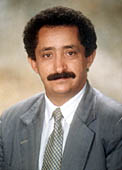
Taking a Stab at a Big Monster [Archives:1998/34/Interview]
August 24 1998
Administrative reform is a key ingredient in our successful development process. Yemen’s public sector – the so-called bureaucracy – is in urgent need of an overhaul. There is a heavy “heritage” of corruption and administrative irregularities which inflict a big cost on doing any kind of work in this country.

Mr. Hussain Al-Ahjuri, Deputy Minister of Civil Service and Administrative Reform (Workforce and Training Sector), talked to Ismail Al-Ghabiry of Yemen Times.
Excerpts:
Q: Could you tell us a bit about the Workforce and Training Sector at your ministry?
A: This sector is one of the main components of the ministry’s organizational structure. It is responsible for planning, managing, and developing the workforce in the various government bodies.
The Workforce and Training Sector is responsible for ascertaining the needs of the state for manpower. Training programs are formulated in coordination with the bodies concerned with planning, education and training to develop workers’ abilities.
Our department is further responsible for collecting and analyzing data related to the country’s workforce.
Q: How are your sector’s various tasks carried out?
A: Unfortunately, the Workforce and Training Sector is not always able to successfully implement its tasks, as stipulated by the enacted laws and legislations. This is due to various reasons.
The strongest hindering factor is the overlap of responsibilities between our sector and other organs with somewhat similar duties. So the Workforce Sector is sometimes limited to doing some executive and procedural tasks. These include:
* employment procedures for people outside the ministry’s jurisdiction;
* preparing the workforce balance and communicating it to the civil service offices in the governorates;
* regulating the procedures of employing foreigners in the public and mixed sectors;
* organizing and redistributing the surplus workforce over various administrative units;
* analyzing statistics on new graduates and their specialties and informing the organs concerned with instituting employment balance;
* implementing the procedures for training people both in Yemen and abroad, especially employees of the health sector.
Q: What are the tasks that face some problems during implementation?
A: Other responsibilities which are not fully carried out by us due to the reasons I mentioned previously include analyzing the workforce, specifying the administrative training policies, and coordinating with the relevant bodies. This is despite the fact that such tasks are stipulated by legislation to be our responsibility.
Q: How many employees are there in the public administration sector?
A: According to the results of an experimental survey conducted during June and July, there are around 405,000 employees in the public and mixed sectors.
Q: Wages of public employees are not in tandem with the current cost of living. How can this situation be remedied?
A: The government has been implementing a number of financial and monetary reform plans to produce tangible positive economic results. There is a strong will to go ahead with the financial and administrative reform program to try to eradicate the shortcomings plaguing the state’s administrative system.
On our part, concentrating on training and qualifying public employees will help these people attain better posts and hence better standards of living.
Q: Are there any plans to modernize the civil service system at all?
A: An overall strategy for modernizing the civil service was prepared by the International Development Agency (IDA). This plan has covered the main elements needed for modernizing and developing the civil service in Yemen. It also includes the basic factors of a comprehensive reform process, targeting the workforce management. This project will be submitted to the National Conference to be fully studied and adapted to the situation in Yemen.
Q: Could you tell us more about the National Conference you just mentioned?
A: The National Conference on Administrative and Financial Reform and Development will be held during 25-29 August. It comes as the culmination of prior intensive efforts and planning by the executives of various relevant ministries. Plans are also being implemented to complete the general survey of public service and the general register.
The conference aims to enhance administrative reform and modernization through the following:
– creating public awareness of the importance of reform and modernization;
– focusing official and public efforts on dealing with the requirements of the administrative reform;
– conducting a number of studies and formulating plans and executive programs for the reform package.
Q: What will be the conference’s main topics of discussion?
A: There will be five main topics: 1- methodology and decision making in administrative reform and development; 2- evaluating and developing the elements of institutional structure within the framework of administrative reform and development; 3- developing management efficiency; 4- administrative environment conducive to private-sector investments; and 5- transparency of the administrative and financial system.
Q: Are there any plans to lay-off some public employees by taking early retirement as part of the reform package?
A: This issue has been discussed exhaustively by all relevant public organs. People who have either reached retirement age or finished the legal duration of their tenure will be encouraged to retire. They will be given various incentives such as full pensions and end-of-service rewards.
Early retirement will also be encouraged to help down-size the over-staffed administrative system. Such people will be paid a whole year’s salary and will be provided with training opportunities to start their own businesses.
——
[archive-e:34-v:1998-y:1998-d:1998-08-24-p:./1998/iss34/intrview.htm]


